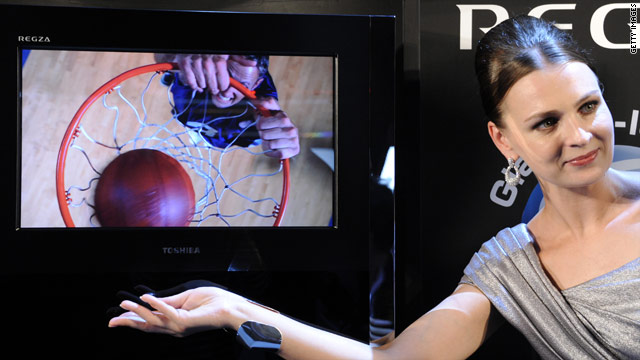Toshiba unveils 3-D TV that doesn't need special glasses

- Toshiba is getting lion's share of buzz at Ceatec with glasses-less 3D TV
- Device was announced last night and people flocked to demonstration
- You have to sit very close to the center of the screen to get the effect
- The 12-inch 3D TV goes on sale in Japan at the end of this year for $1,500
(CNET) -- Ceatec didn't officially start until Monday, but Toshiba was already getting the lion's share of the buzz here on the show floor, with its glasses-less 3D TV.
The device was announced Sunday night, and people flocked to the demonstration in a dark makeshift theater Monday, where the wait was nearly an hour. The reason? Because finally, mercifully, a TV maker has come up with a way to watch 3D at home without those ridiculous plastic glasses.
There were three sizes on display: 12 inches, 20 inches, and 56 inches. While the smaller size models are destined for the Japanese market in December, the 56-incher is just a prototype and there are no imminent plans to make it into an actual product, according to a Toshiba representative here.
The 3D Regza TV uses the Cell Broadband Engine that takes a 2D image and then simultaneously creates nine images of it from nine different directions, in real time. It's displayed on a high-definition LED TV.
CNET: Watch an explanation video of how the technology works
After spending some time in the theater, we found the TV works surprisingly well. It's not a 3D cinema-quality experience, and there's clearly room to improve, but again, you don't have to wear any glasses.
Still images fare better than moving images. And you have to sit (though we stood during the demo) very close to the center of the screen to get the effect.
With the 12-inch version, move more than a few inches to the left or right and the 3D effect is lost. However, the viewing angle was better on the 20-inch model, and the best on the 56-inch one.
And there's another matter of practicality: to get the best effect, you have to stand pretty close to the LED TV, closer than any normal person would want to for fear singeing their retinas.
That's why the glasses-less 3D laptop, a Toshiba Dynabook, is a far more realistic application of the glasses-less technology: It's the same size as the 12-inch TV, but since it's natural to sit very close to a laptop and look at it straight on, the aforementioned problems are negated.
The 12-inch 3D TV goes on sale in Japan at the end of this year for 120,000 yen, or $1,500. The 20-inch will have a 240,000 yen price tag, or about $2,900.
Sorry, rest of the world, you'll have to wait, since there's no timetable for bringing either to other markets.
© 2010 CBS Interactive Inc. All rights reserved. CNET, CNET.com and the CNET logo are registered trademarks of CBS Interactive Inc. Used by permission.

